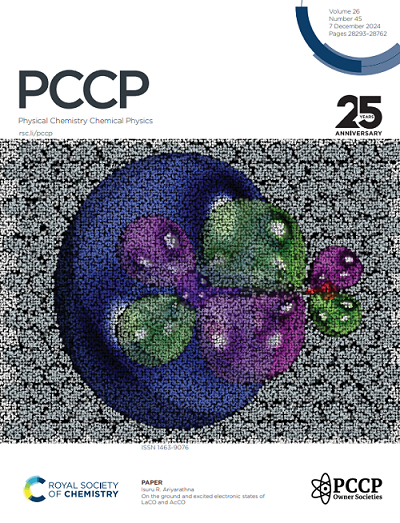非热等离子体气泡促进二氧化碳加速矿化和多晶化控制
IF 2.9
3区 化学
Q3 CHEMISTRY, PHYSICAL
引用次数: 0
摘要
二氧化碳矿化对于开发净负碳技术很有意义,这些技术通过去除和封存大气中的二氧化碳来模拟自然碳循环。本研究研究了等离子体-液体相互作用(PLI)以及改变非热CO2等离子体的电子温度对碳酸钙(CaCO3)成核和生长动力学的影响。通过对等离子体放电参数的优化,我们发现在一定条件下,等离子体-液体相互作用可以指导纯钙矾石相CaCO₃在热力学更稳定的方解石相上的形成。通过改变等离子体气泡中CO₂/Ar混合物放电的摩尔分数,我们发现增加电子温度可以提高CO₂的捕获、成核速率和CaCO₃的产率。通过改变流动中的Ar摩尔分数来提高等离子体的电子温度,与纯CO₂相比,CO₂转化率提高了近10倍,但通过CO2解离增加了一氧化碳的竞争性形成。当平均电子能量为~1 eV时,对CaCO₃的选择性最大。我们的研究结果支持了一种机制,即二氧化碳矿化是通过二氧化碳的气相振动激发和等离子体-液体界面通过等离子体活化水分裂产生活性羟基物质同时驱动的。这些等离子体生成的物质反应产生HCO3-,这是二氧化碳矿化的速率决定步骤。通过证明等离子体-液体界面上固体碳酸盐形成的加速矿化动力学和多态控制,该研究可能对工程净负碳封存技术转化为长期储存的固体形式具有更广泛的相关性。本文章由计算机程序翻译,如有差异,请以英文原文为准。
Accelerated Carbon Dioxide Mineralization and Polymorphic Control Facilitated by Nonthermal Plasma Bubbles
Mineralization of carbon dioxide is of interest for developing net-negative carbon technologies that mimic natural carbon cycles by removing and sequestering atmospheric carbon dioxide (CO₂). This study investigates plasma-liquid interactions (PLI) and the impact of modifying electron temperatures of nonthermal CO2 plasmas to modify the nucleation and growth kinetics of calcium carbonate (CaCO3). Through optimization of plasma discharge parameters, we show that plasma-liquid interactions can direct the formation of a pure vaterite phase CaCO₃ over the more thermodynamically stable calcite phase under certain conditions. By varying the mole fraction of the discharge between a mixture of CO₂/Ar in the plasma bubbles, we show that increasing electron temperature enhances CO₂ capture, nucleation rate, and CaCO₃ yields. Increasing the electron temperature of the plasma by varying the Ar mole fraction in the flow increases CO₂ conversion nearly tenfold compared to pure CO₂ yet increases the competitive formation of carbon monoxide through CO2 dissociation. When average electron energies were ~1 eV, the greatest selectivity toward CaCO₃ was observed. Our results support a mechanistic picture in which CO2 mineralization is driven concurrently through gas-phase vibrational excitation of CO2 and at the plasma-liquid interface by generating reactive hydroxyl species from plasma-activated water splitting. These plasma-generated species react to produce HCO3-, the rate-determining step in CO2 mineralization. By demonstrating accelerated mineralization kinetics and polymorphic control of solid carbonate formation at plasma-liquid interfaces, this study could have broader relevance for engineering net-negative carbon sequestration technologies into solid forms for long-duration storage.
求助全文
通过发布文献求助,成功后即可免费获取论文全文。
去求助
来源期刊

Physical Chemistry Chemical Physics
化学-物理:原子、分子和化学物理
CiteScore
5.50
自引率
9.10%
发文量
2675
审稿时长
2.0 months
期刊介绍:
Physical Chemistry Chemical Physics (PCCP) is an international journal co-owned by 19 physical chemistry and physics societies from around the world. This journal publishes original, cutting-edge research in physical chemistry, chemical physics and biophysical chemistry. To be suitable for publication in PCCP, articles must include significant innovation and/or insight into physical chemistry; this is the most important criterion that reviewers and Editors will judge against when evaluating submissions.
The journal has a broad scope and welcomes contributions spanning experiment, theory, computation and data science. Topical coverage includes spectroscopy, dynamics, kinetics, statistical mechanics, thermodynamics, electrochemistry, catalysis, surface science, quantum mechanics, quantum computing and machine learning. Interdisciplinary research areas such as polymers and soft matter, materials, nanoscience, energy, surfaces/interfaces, and biophysical chemistry are welcomed if they demonstrate significant innovation and/or insight into physical chemistry. Joined experimental/theoretical studies are particularly appreciated when complementary and based on up-to-date approaches.
 求助内容:
求助内容: 应助结果提醒方式:
应助结果提醒方式:


